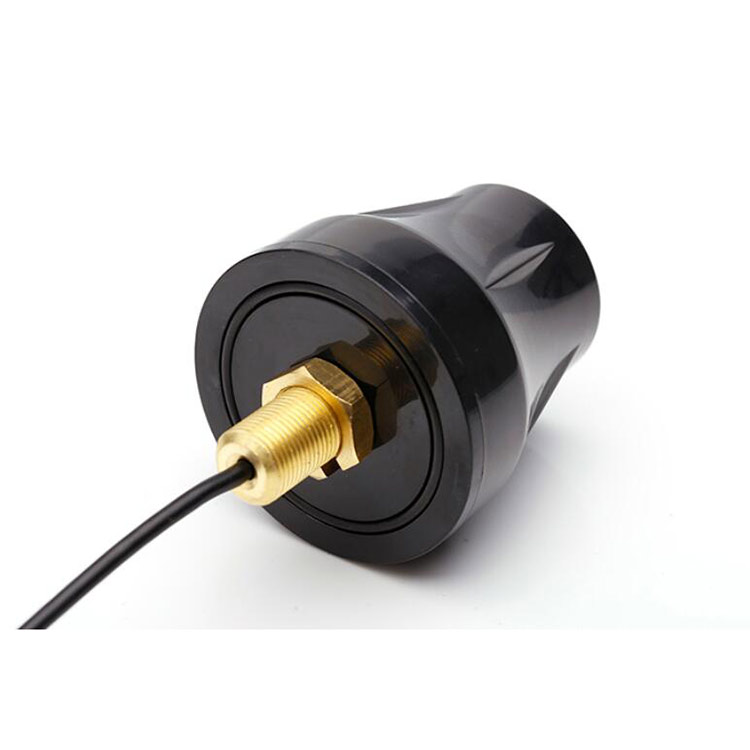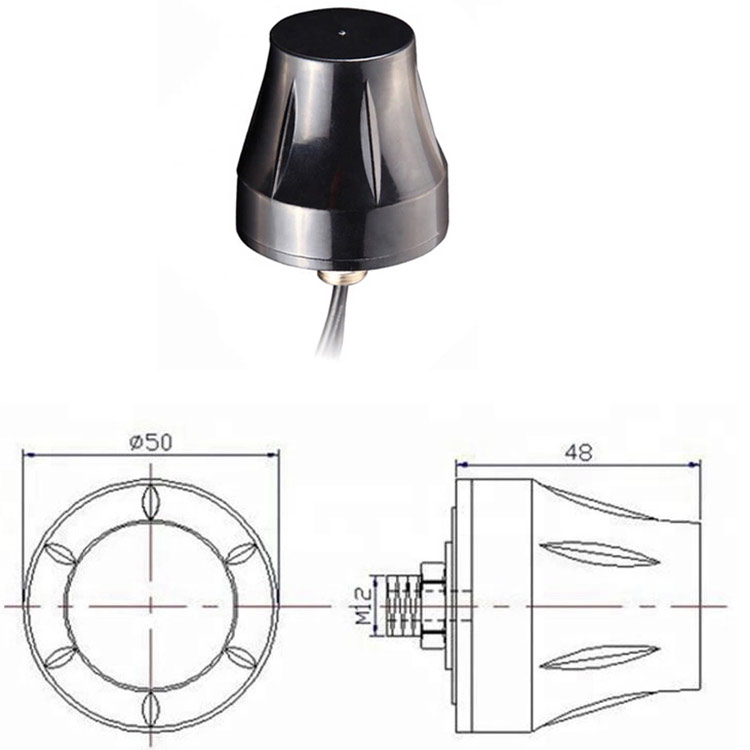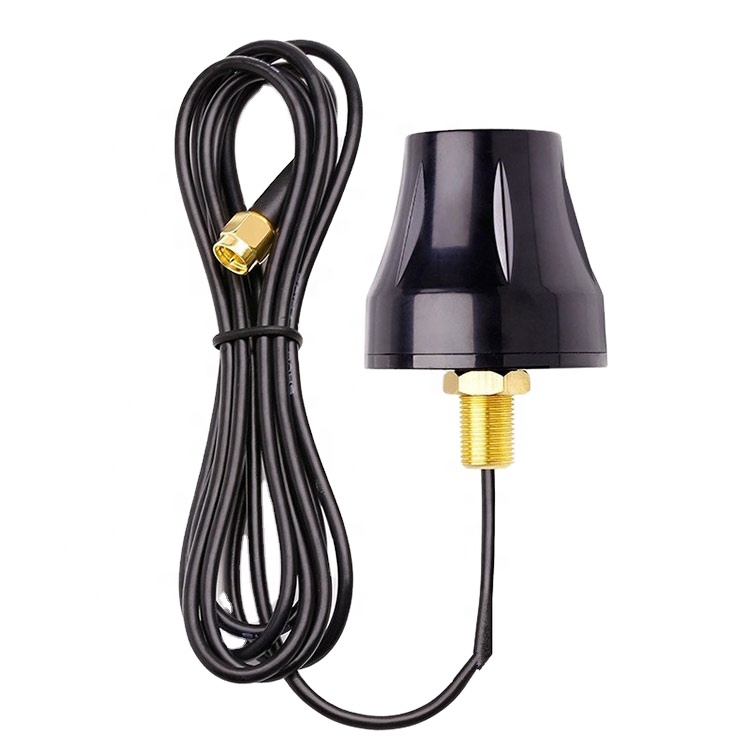GPS, or Global Positioning System, operates by receiving signals from a constellation of satellites orbiting the Earth. These signals carry essential information about the satellite's position and time, allowing GPS receivers to calculate their precise location on Earth's surface. However, the weak nature of these signals, often in the range of -160 dBm when reaching the Earth, combined with the challenging outdoor environment, pose significant obstacles to accurate positioning. Outdoor screw mount waterproof GPS antennas are designed to overcome these challenges.
The “screw mount” feature of these antennas provides a secure and stable installation method, ensuring that the antenna remains firmly in place even in the face of strong winds, vibrations, and other mechanical disturbances. This is particularly important for applications on moving vehicles or equipment, where a loose antenna could lead to signal loss and inaccurate positioning. The “waterproof” aspect is equally vital, as outdoor environments are often exposed to rain, snow, and high humidity. A waterproof design prevents water ingress, which can damage the internal components of the antenna and disrupt its operation.
These antennas have found extensive use across multiple sectors. In the maritime industry, they are essential for ship navigation, enabling vessels to determine their position accurately in open seas and near coastlines, even during storms. In the transportation and logistics industry, trucks and delivery vehicles equipped with such antennas can maintain continuous and accurate positioning, facilitating efficient route planning and real - time tracking of goods. Additionally, in outdoor recreational activities like hiking, camping, and off - road driving, portable devices with these antennas can help adventurers navigate unfamiliar terrains safely. As the demand for reliable outdoor positioning continues to grow, the importance of outdoor screw mount waterproof GPS antennas is set to increase further, driving innovation in their design and functionality.
The design and construction of an outdoor screw mount waterproof GPS antenna are carefully crafted processes that combine advanced antenna engineering, robust material selection, and specialized manufacturing techniques to ensure optimal performance, durability, and environmental resistance.
Antenna Element Design
The core of the outdoor screw mount waterproof GPS antenna is the antenna element, which is responsible for capturing the weak GPS signals from satellites. Microstrip antenna designs are commonly employed due to their compact size and ease of integration with other components. A microstrip antenna typically consists of a metallic patch, usually made of copper or gold, placed on a dielectric substrate with a ground plane beneath it.
The shape, size, and configuration of the metallic patch are meticulously optimized through electromagnetic simulations to resonate at the specific frequencies of GPS signals, primarily in the L - band range (e.g., 1.575 GHz for the L1 band). These simulations help engineers fine - tune the patch to achieve high gain, good impedance matching, and an appropriate radiation pattern. High gain ensures that the antenna can effectively capture weak GPS signals, while proper impedance matching minimizes signal reflections, improving the overall efficiency of signal reception.
The choice of dielectric substrate is also crucial. Materials with stable electrical properties over a wide range of temperatures and humidity levels are preferred. Ceramic - based substrates are often used because of their high dielectric constant, which allows for miniaturization of the antenna without sacrificing performance. They also exhibit excellent thermal stability and mechanical strength, making them suitable for the harsh outdoor environment.
Waterproof and Weatherproof Enclosure
The most distinctive feature of an outdoor screw mount waterproof GPS antenna is its enclosure, which is designed to protect the internal components from water, dust, and other environmental elements. The enclosure is typically made from high - quality, durable materials such as polycarbonate, ABS plastic, or aluminum alloys.
Polycarbonate and ABS plastic enclosures offer good impact resistance, UV resistance, and chemical resistance, making them suitable for general outdoor applications. They can withstand exposure to sunlight, rain, and temperature fluctuations without significant degradation. Aluminum alloy enclosures, on the other hand, provide superior mechanical strength and electromagnetic shielding, which can be beneficial in environments with high levels of electromagnetic interference or where the antenna may be subject to physical impacts.
To achieve waterproofing, the enclosure is designed with tight - fitting seals and gaskets. O - rings are commonly used around openings such as connectors, mounting holes, and access panels. These O - rings create a watertight barrier, preventing water from entering the enclosure. The seams and joints of the enclosure are often sealed with waterproof adhesives or gaskets to further enhance the waterproof performance. In addition, the enclosure may be designed with a sloped or curved surface to facilitate the runoff of water, reducing the chance of water pooling on the antenna.
Screw Mounting Mechanism
The screw mount design of the antenna provides a secure and stable installation solution. The antenna typically features a threaded base or mounting flange that allows it to be screwed onto a compatible surface, such as the roof of a vehicle, a mast, or a fixed structure. The mounting holes are designed to match standard screw sizes, ensuring easy installation and compatibility with a wide range of mounting accessories.
To prevent loosening due to vibrations and mechanical stress, locking nuts, washers, or thread - locking compounds are often used during installation. The screw mount mechanism not only ensures that the antenna remains in place but also helps in minimizing vibrations that could potentially affect signal reception. Additionally, the design of the screw mount allows for easy adjustment of the antenna's orientation, enabling users to optimize the antenna's position for the best signal reception.
Electrical Components and Assembly
Inside the enclosure, the antenna houses electrical components such as a low - noise amplifier (LNA) and associated circuitry. The LNA is a critical component that amplifies the weak GPS signals received by the antenna element while adding minimal noise. It is carefully selected for its high gain, low noise figure, and wide bandwidth to ensure effective amplification of the GPS signals within the required frequency range.
The electrical components are assembled on a printed circuit board (PCB) with careful consideration given to signal routing, impedance matching, and electromagnetic compatibility. The PCB layout is designed to minimize electromagnetic interference (EMI) and ensure proper signal integrity. Shielding techniques may be employed to protect the sensitive electrical components from external EMI sources.
The antenna is then carefully assembled, with all components securely mounted and connected. Before finalizing the assembly, rigorous testing is conducted to ensure that the antenna meets the required performance standards, including signal reception, waterproofing, and mechanical stability.
The working principles of an outdoor screw mount waterproof GPS antenna are centered around the processes of signal reception, amplification, and transmission to the GPS receiver, all while maintaining reliable operation in the challenging outdoor environment.
Signal Reception
The operation of the antenna begins with the antenna element capturing the weak radio - frequency signals transmitted by GPS satellites. These signals, carrying information about the satellite's position and time, travel through the Earth's atmosphere and reach the antenna. The antenna element, with its precisely tuned resonant frequency and radiation pattern, is designed to efficiently couple with the incoming GPS signals.
When the frequency of the incoming GPS signals matches the resonant frequency of the antenna element, a resonance effect occurs. This resonance enhances the antenna's ability to absorb the energy of the signals, converting the electromagnetic energy of the GPS signals into electrical signals. The metallic patch on the antenna element plays a crucial role in this process, as it interacts with the electromagnetic fields of the GPS signals, generating induced electrical currents that represent the received signals. However, these initial electrical signals are extremely weak and require further processing.
Signal Amplification
The weak electrical signals generated by the antenna element are then fed into a low - noise amplifier (LNA) located inside the antenna enclosure. The primary function of the LNA is to amplify these weak GPS signals while keeping the added noise to a minimum. This is essential because the signals received from the satellites are already very weak, and any additional noise could significantly degrade the accuracy of the positioning calculations performed by the GPS receiver.
The LNA uses specialized semiconductor devices, such as field - effect transistors (FETs) or bipolar junction transistors (BJTs), which are designed to have low noise characteristics. The gain of the LNA is carefully controlled to ensure that the signals are amplified to an appropriate level without causing distortion or overloading the subsequent components in the circuit. After amplification, the signals are in a stronger state, making them more suitable for further processing and transmission to the GPS receiver.
Signal Transmission and Filtering
The amplified signals are then passed through a series of filters within the antenna's circuitry. Band - pass filters are commonly used to allow only the frequencies within the GPS signal band to pass through while attenuating frequencies outside this band. This helps to reject interference from other radio - frequency sources operating at different frequencies, such as wireless communication devices, radio transmitters, or electrical equipment present in the outdoor environment.
Notch filters may also be employed to specifically target and attenuate certain frequencies that are known to cause interference. For example, in areas where there are strong local radio signals, notch filters can be tuned to suppress those frequencies, ensuring that only the clean and relevant GPS signals are transmitted to the GPS receiver.
Finally, the filtered and amplified signals are transmitted from the antenna to the GPS receiver via a coaxial cable or other suitable transmission medium. The GPS receiver then uses these signals to calculate the time - of - arrival (TOA) or time - difference - of - arrival (TDOA) of the signals from multiple satellites. By comparing the TOA or TDOA of signals from different satellites and knowing the position of the satellites in orbit, the GPS receiver can calculate the precise location of the antenna (and thus the device it is attached to) on Earth's surface using the principle of trilateration.
Throughout this process, the waterproof and rugged design of the antenna ensures that the internal components remain protected from the outdoor elements, allowing the antenna to continue operating reliably and providing accurate signals to the GPS receiver.
-
Advantages
One of the most significant advantages of outdoor screw mount waterproof GPS antennas is their exceptional durability and reliability in outdoor environments. The waterproof enclosure, combined with the robust screw mount design, allows the antenna to withstand a wide range of environmental challenges, including heavy rain, snow, dust storms, and extreme temperatures. This makes them ideal for long - term outdoor use, ensuring continuous and accurate positioning even in the harshest conditions.
The secure screw mount installation provides stability, reducing the risk of signal loss due to antenna movement or dislodgment. This is particularly important for applications on moving vehicles, boats, or equipment, where vibrations and mechanical stress are common. The ability to maintain a stable position ensures consistent signal reception, enhancing the overall performance of the GPS system.
These antennas also offer good signal reception capabilities. The combination of the optimized antenna element design and the built - in low - noise amplifier enables them to effectively capture weak GPS signals, even in areas with limited satellite visibility or where signal obstruction is present. This is crucial for accurate positioning in challenging outdoor terrains, such as mountainous regions or urban canyons.
Another advantage is their versatility. They can be installed on a variety of surfaces and structures, making them suitable for a wide range of applications, from maritime and automotive to outdoor scientific research and recreational activities. Their compatibility with different GPS receivers and systems further adds to their versatility, allowing for easy integration into existing setups.
Challenges
Despite their many advantages, outdoor screw mount waterproof GPS antennas face several challenges. One of the primary challenges is electromagnetic interference (EMI). In outdoor environments, there can be various sources of EMI, including power lines, communication towers, and other electronic devices. EMI can disrupt the operation of the antenna, leading to inaccurate positioning or signal loss. To mitigate this, advanced shielding techniques and careful circuit design are required, which can increase the complexity and cost of the antenna.
Another challenge is related to the long - term exposure to environmental elements. Even with a waterproof design, over time, seals and gaskets may degrade due to UV radiation, temperature cycling, or chemical exposure. This can lead to water ingress and damage to the internal components. Regular maintenance and inspection are necessary to ensure the continued waterproof performance of the antenna, which can be time - consuming and costly, especially for large - scale deployments.
The screw mount design, while providing stability, also requires proper installation. Incorrect installation, such as over - tightening or under - tightening the screws, can lead to damage to the antenna or the mounting surface, and may also affect the antenna's performance. Ensuring that installation is carried out correctly requires trained personnel and appropriate tools, adding to the overall complexity of deployment.
Finally, the cost of these antennas can be relatively high compared to standard indoor - only GPS antennas. The use of high - quality materials, advanced manufacturing techniques, and the need for rigorous testing to ensure waterproof and environmental resistance contribute to the higher cost. This cost factor may be a barrier for some applications, especially those with budget constraints.
-
Applications
Outdoor screw mount waterproof GPS antennas have a wide range of applications across multiple industries. In the maritime industry, they are an essential component of ship navigation systems. Ships rely on these antennas to determine their position accurately, navigate safely through busy waterways, avoid hazards, and follow planned routes. They are also used in marine research vessels for precise positioning during scientific surveys and data collection.
In the transportation and logistics industry, trucks, buses, and delivery vehicles are often equipped with these antennas. The accurate positioning provided by the antennas enables real - time tracking of vehicles, optimizing route planning, improving delivery efficiency, and enhancing fleet management. In addition, for long - haul trucking, the durability and reliability of these antennas ensure continuous operation over long distances and in various weather conditions.
In the outdoor recreational sector, outdoor enthusiasts use devices with these antennas for activities such as hiking, camping, off - road driving, and boating. Portable GPS devices with waterproof antennas allow adventurers to navigate unfamiliar terrains, find their way back to base camps, and ensure their safety in remote areas.
These antennas are also used in outdoor scientific research, such as environmental monitoring, wildlife tracking, and geological surveys. They enable researchers to accurately record the location of data collection points, track the movement of animals, and monitor changes in the environment over time.
Future Trends
Looking ahead, several future trends are expected to shape the development of outdoor screw mount waterproof GPS antennas. One trend is the integration of multiple satellite navigation systems. In addition to GPS, other global navigation satellite systems (GNSS) such as GLONASS, Galileo, and BeiDou are becoming more prevalent. Future antennas will be designed to receive signals from multiple GNSS simultaneously, providing greater redundancy and enhanced accuracy, especially in areas where GPS signals alone may not be sufficient.
Advancements in materials science will lead to the development of more durable and lightweight materials for antenna enclosures. New materials with improved resistance to UV radiation, temperature extremes, and chemical corrosion will be developed, reducing the need for frequent maintenance and extending the lifespan of the antennas. Additionally, the use of advanced sealing technologies will further enhance the waterproof performance of the antennas.
The miniaturization of antenna components is also an emerging trend. As technology progresses, the size of the antenna elements, amplifiers, and other internal components will decrease, while maintaining or even improving performance. This will enable the development of smaller and more compact outdoor screw mount waterproof GPS antennas, which can be more easily integrated into a wider range of devices and applications.
The integration of artificial intelligence (AI) and machine learning (ML) algorithms into antenna design and operation is another future trend. AI and ML can be used to optimize the antenna's performance in real - time, adapt to changing environmental conditions, and automatically detect and mitigate interference. For example, AI - powered antennas could analyze incoming signals and adjust their reception parameters to maximize signal quality, improving the overall accuracy and reliability of the positioning system.
Conclusion
In conclusion, outdoor screw mount waterproof GPS antennas are indispensable for reliable outdoor positioning in a variety of applications. Their unique combination of a secure screw mount design and waterproof enclosure makes them highly suitable for withstanding the rigors of the outdoor environment, ensuring consistent and accurate signal reception.
However, challenges such as electromagnetic interference, long - term environmental exposure, proper installation, and cost need to be addressed. Overcoming these challenges will require continuous innovation in design, materials, and manufacturing processes, as well as the adoption of emerging technologies.
As the demand for accurate outdoor positioning continues to grow across various industries and activities, the future of outdoor screw mount waterproof GPS antennas looks promising. With trends such as multi - GNSS integration, advancements in materials science, miniaturization, and the integration of AI and ML, these antennas will continue to evolve and play an even more significant role in enabling seamless navigation, tracking, and monitoring in the great outdoors. They will contribute to the development of more efficient, safe, and intelligent outdoor systems, facilitating a wide range of human activities and scientific research in the outdoor environment.




































































 Language
Language
 En
En Cn
Cn Korean
Korean

 Home >
Home > 








 18665803017 (Macro)
18665803017 (Macro)













